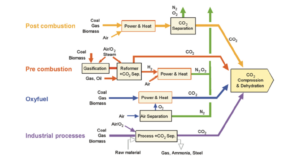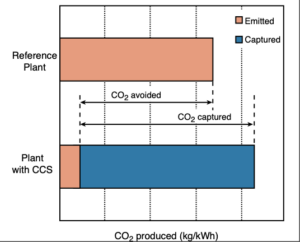Nicolas Rapp
Despite the precarious situation of the global climate, many countries are far from achieving their climate targets and complying with the Paris Agreement. The burning of fossil fuels leads to a massive increase in the concentration of CO2 in the atmosphere. The so-called “Carbon Capture and Storage” methods are said to be a promising solution for minimizing these emissions.
The basic principle of the CCS methods is that the produced CO2 is separated and stored in the ground as a gas, liquid or supercritical fluid. This is mainly used in power plants and industrial plants. The approach of CCS is intended to reduce CO2 emissions into the atmosphere (Raza, Gholami, Rezaee, Rasouli, & Rabiei, 2019). There are also CCS processes, such as “Direct Air Carbon Capture and Storage (DACCS)” or the “Bioenergy with Carbon Capture and Storage (BECCS)” process, which were developed to remove greenhouse gases from the atmosphere, so-called negative emissions (BAFU, 2022). In the following, however, I will mainly refer to the CCS methods for power plants and industrial plants.

Figure 1 Schematic overview of CCS (Titz, 2016)
Various processes are being researched and already being developed for the separation of CO2. A distinction is made between three main variants.
On one hand, there is “post-combustion capture”, whereby the CO2 is filtered out of the exhaust gases with the help of chemicals after the combustion of a fossil fuel (IPCC, 2005; Robinius, Markewitz, & Zhao, 2017).
Another method would be «pre-combustion capture». The aim here is to separate the CO2 before the fuel is burned. Hydrocarbonates are split into CO2 and hydrogen. The CO2 is then stored, and the hydrogen used as fuel (IPCC, 2005; Robinius et al., 2017).
In the last variant, “oxyfuel combustion”, the fuel is not burned with atmospheric air but with pure oxygen. Combustion then produces steam and CO2. The water vapor can be condensed, leaving a stream of CO2 that is ideally as pure as possible, which can then be extracted and stored (Robinius et al., 2017).
The various methods have their advantages and disadvantages depending on the scope of the application (IPCC, 2005; Raza et al., 2019; Robinius et al., 2017). In all processes, the separated CO2 is then transported to its storage location, often in pipelines. The choice of repository is not easy and depends on many parameters. Above all, exhausted oil and gas fields, as well as deep, saline, water-bearing rock strata are ideal for storing the CO2 obtained. However, a number of other parameters also play a role in making storage as safe as possible (Raza et al., 2019).

Figure 2 Overview of CO2 capture processes and systems (IPCC, 2005)
What speaks for the CCS procedure?
Climate change is in full swing. The CO2 content in the atmosphere and thus the global average temperature is increasing. According to Statista, the generation of electricity and heat causes the largest share of emissions. The industrial sector also makes a significant contribution to global CO2 emissions (statista, 2020). Coal, oil and gas still play an important role in global electricity supply. The three fossil fuels account for over 50% of global energy production (statista, 2021). Even if the expansion of renewable energies is progressing, fossil fuels will still be relevant in the future. There is still a long way to go before we are completely greenhouse gas neutral. This time must be bridged somehow without causing too much damage. This is where the idea of the CCS process comes in. The development of these technologies should help minimizing the CO2 emissions into the atmosphere by conventional power plants (especially coal and oil). The reduction in emissions could amount to as much as 72-78% (Fischedick et al., 2007).

Figure 3 capture and storage from power plants (IPCC, 2005)
According to the International Energy Agency (IEA) CCS could contribute up to 19% of the emission reduction needed, in order not to exceed the two-degree limit (International Energy Agency, 2008). In addition, the process-related emissions in the industrial sector, for example, cannot be replaced by, for example, renewable energies, as is the case with electricity production. Therefore, these carbon capture and storage methods could, for example, make steel and iron production or cement production more environmentally friendly (Matthes & Ott, 2010; Robinius et al., 2017; Titz, 2018).
Challanges to face
However, there are several difficulties with the expansion of these processes, which have already led to several discussions in recent years. The emissions of a power plant despite a CCS system are still far higher than those of renewable energies and nuclear power plants (Fischedick et al., 2007). So, it cannot be the long-term goal to rely on these technologies if you want to achieve a net zero goal. Another very central aspect is the enormous amount of energy required to separate the CO2. Depending on the process, this additional energy consumption can amount to 20-44% (Fischedick et al., 2007). This high energy input means that the efficiency of the system where the CO2 is captured is reduced, which in turn increases costs (ProClim- & OcCC, 2009; Robinius et al., 2017). In addition, the development and operation of the infrastructure, e.g. the necessary facilities and possibly a pipeline network for transport, are extremely expensive. According to Hermann E. Ott (2010), these costs would exceed those of switching to renewable energies. The prices for renewable energy production are becoming more and more competitive over time, which means that CCS methods for power plants running on fossil fuels continue to fall behind (Hermann, 2021).
Another aspect that speaks against storing large amounts of CO2 in the ground is the safety of the disposal sites. Greenpeace, for example, warns that the contaminated sites in the repositories will pose a safety risk in the future. They mainly talk about leaks in the bearing points, the exclusivity of which has not been proven and which could lead to problems in the future. If the gas were to escape from the ground through outgassing, this could lead to a significant risk of asphyxiation for people and animals (Fischedick et al., 2007; Greenpeace, 2019). For improving safety, the storage site would have to be monitored during and after the injection, which means additional costs (Raza et al., 2019). The escaping gas could also acidify overlying groundwater or seawater, which could have a significant impact on these ecosystems and their food chains (Fischedick et al., 2007).
Conclusion
Opinions regarding CCS methods differ widely. For example, the Intergovernmental Panel on Climate Change (IPCC) recommends investing in the technology under certain conditions. On the other hand, there are some environmental organizations, including Greenpeace, which categorically reject the storage of CO2 (Hermann, 2021). The extremely high cost is one reason why the technology has not yet been installed on a wide scale. However, the sharp rise in prices to buy the right to CO2 emissions through the emissions trading system could put CCS systems in a new light and stimulate discussions (Hermann, 2021).
Personally, I think that the CCS technology should be expanded. The methods should be used more, especially in the case of the unavoidable CO2 emissions in the industrial sector. In addition, new technologies can emerge from research, such as “direct air carbon capture and storage” or “bioenergy with carbon capture and storage”, which do not minimize CO2 emissions, but lead directly to negative emissions (Titz, 2018). Further research in this area could reduce operating costs and energy consumption for CCS systems, making them more profitable (Raza et al., 2019). I think that climate change is too big a problem to miss such an opportunity, which is not perfect but nevertheless helpful. The arguments against large-scale use of CCS are, in my opinion, necessary evils that need to be addressed to avert even more devastating effects of climate change. Nevertheless, one must clearly recognize that CCS alone is not enough. When applied on a large scale, the systems can play an important role, but the method alone cannot make the difference.
Sources
BAFU. (2022). Negativemissionstechnologien. Retrieved May 4, 2022, from https://www.bafu.admin.ch/bafu/de/home/themen/klima/fachinformationen/emissionsverminderung/negativemissionstechnologien.html
Fischedick, M., Esken, A., Pastowski, A., Schüwer, D., Supersberger, N., Nitsch, J., … Edenhofer, O. (2007). Strukturell-ökonomisch-ökologischer Vergleich regenerativer Energietechnologien mit Carbon Capture and Storage. Wuppertal, Stuttgart, Potsdam. Retrieved from https://www.dlr.de/tt/Portaldata/41/Resources/dokumente/institut/system/publications/RECCS-Endbericht-gesamt.pdf
Greenpeace. (2019). Irrweg CCS. Retrieved May 1, 2022, from Greenpeace website: https://www.greenpeace.de/klimaschutz/energiewende/kohleausstieg/ccs
Haszeldine, S. (2009). Carbon capture and storage: How Green Can Black Be? Science, 325(September), 1647–1652. https://doi.org/10.1016/C2009-0-19306-6
Hermann, R. (2021). Norwegen will seinen Erdgasreichtum mit dem Klimaschutz unter einen Hut bringen. NZZ. Retrieved from https://www.nzz.ch/wirtschaft/co2-abscheidung-norwegens-neue-klimaschutzstrategie-ld.1597404
International Energy Agency. (2008). Energy Technology Perspectives. In Strategies. Retrieved from https://iea.blob.core.windows.net/assets/0e190efb-daec-4116-9ff7-ea097f649a77/etp2008.pdf
IPCC. (2005). IPCC Special Report on Carbon Dioxide Capture and Storage (B. Metz, O. Davidson, H. de Coninck, M. Loos, & L. Meyer, Eds.). Cambridge: Cambridge University Press. https://doi.org/10.1016/bs.ache.2021.10.005
Matthes, F. C., & Ott, H. E. (2010). Pro und Contra CCS. Zeitschrift Für Sozialistische Politik Und Wirtschaft, 176. Retrieved from https://www.spw.de/xd/public/content/index.html?sid=heftarchiv&year=2010&bookletid=10
ProClim-, & OcCC. (2009). Technischer Klimaschutz: Wo steht die CCS-Technologie? Climate Press, (27). Retrieved from https://portal-cdn.scnat.ch/asset/58e956d5-f19f-5a53-a472-69e351219d96/775.pdf?b=04630721-1aa0-5e2f-9260-0ebed2d6f4b0&v=98011c08-bd50-5a87-9625-e4adc590fdc7_0&s=kOK8ua4zrn51fGsswvZbHLMkWmALvwE3iSYTNewnrEPXjed0JcIO2XIr335CT7EOEP-MT2QNjB9Zf-vWo55MvSef5dLtje
Raza, A., Gholami, R., Rezaee, R., Rasouli, V., & Rabiei, M. (2019). Significant aspects of carbon capture and storage – A review. Petroleum, 5(4), 335–340. https://doi.org/10.1016/j.petlm.2018.12.007
Robinius, M., Markewitz, P., & Zhao, L. (2017). Technologiebericht 2.3 CO2-Abscheidung und Speicherung (CCS). 47.
statista. (2020). CO2-Ausstoß weltweit nach Sektoren | Statista. Retrieved April 28, 2022, from https://de.statista.com/statistik/daten/studie/167957/umfrage/verteilung-der-co-emissionen-weltweit-nach-bereich/
statista. (2021). Weltweiter Energiemix nach Energieträger 2019 | Statista. Retrieved April 28, 2022, from https://de.statista.com/statistik/daten/studie/167998/umfrage/weltweiter-energiemix-nach-energietraeger/
Titz, S. (2016). Der Klima-Notnagel steht schief. NZZ. Retrieved from https://www.nzz.ch/wissenschaft/klima/der-klima-notnagel-steht-schief-ld.18808
Titz, S. (2018). CCS-Technologie: Klimaziel von Paris erfordert CO2-Abscheidung. Retrieved May 1, 2022, from NZZ website: https://www.nzz.ch/wissenschaft/ccs-technologie-klimaziel-von-paris-erfordert-co2-abscheidung-ld.1440315